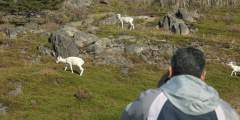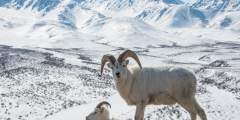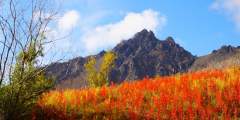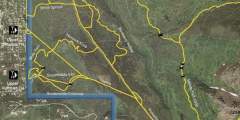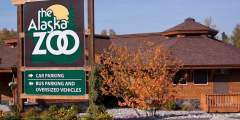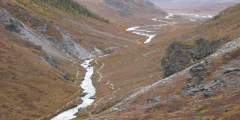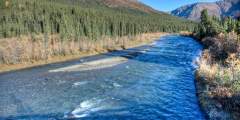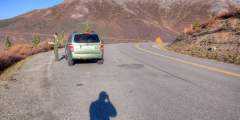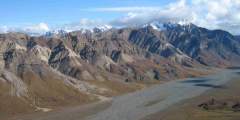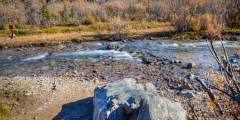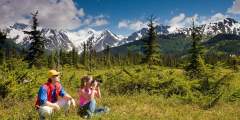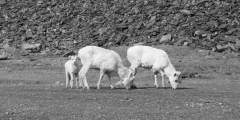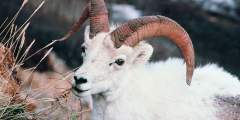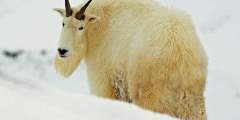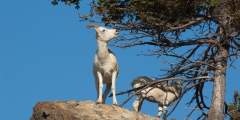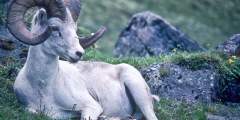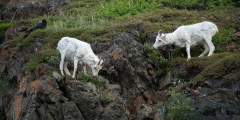Alaska Sheep & Mt. Goat Viewing Spots
Best Places to See Dall Sheep & Mountain Goats
Dall sheep and mountain goats are the charismatic, white-coated grazers of Alaska’s high mountains, denizens of some of the most spectacular country on the planet. Most of the state’s estimated 50,000 sheep and 30,000 goats inhabit remote terrain far from human byways and are generally difficult to see up close without climbing into alpine zones. But both species can be viewed at a distance by scanning certain open slopes—usually where whole mountain faces are visible at a glance—most often when vegetation can provide a backdrop to their fur.
There are two dramatic exceptions to this rule! Dall sheep will venture close to the highway at Windy Corner on Turnagain Arm near Anchorage, sometimes grazing a few yards from parking. Mountain goats will sometimes descend close to sea level in outer Resurrection Bay, Harriman Fiord of Prince William Sound, and on Southeast Alaska headlands, visible to people on marine wildlife tours.
Sheep-Goat Viewing Tips:
- Sheep and goat viewing will be much more satisfying if you use a spotting scope or binoculars. Watch for white dots moving across slopes before and after snow season, and then zero in with good glass.
- These two hooved species can be confused. Mountain goats have sharp black horns, with narrower chests and slightly off-white coats that grow much longer and raggedy in winter. They also sport a distinct goatish “beard.” Dall sheep are very white in appearance, with broader chests. They grow curved, amber-colored horns, with adult rams developing massive full curls.
- Sheep and goats don’t usually overlap. Most goats live on rugged mountain faces of Southeast and coastal Alaska, while Dall sheep inhabit drier alpine zones of mainland ranges like the Alaska, Chugach, Kenai and Wrangell-St. Elias. No sheep live in Southeast.
- EXCEPTION! Several locales in Southcentral Alaska actually attract both species, and they happen to include two road-accessible viewing areas.
- Penguin Ridge above Turnagain Arm (Bird Point Wayside)
- Cooper Landing area of Kenai Mountains (Tern Lake)
- Knik Glacier area
- McColl Ridge in Wrangell-St. Elias National Park
For More Information:
- Dall sheep PDF from Alaska Wildlife Notebook
- A Dall sheep primer from game biologists
- Mountain goat PDF from Alaska Wildlife Notebook
- A mountain goat primer from game biologists
Where Should You Go First?
Jump to: MAP | Windy Corner | Bird Point | Chugach State Park | Tern Lake | Seward & Kenai Fjords | Denali National Park | Sheep Mountain | Rainbow Ridge | Atigun Pass | Guaranteed Viewing | Viewing Tips
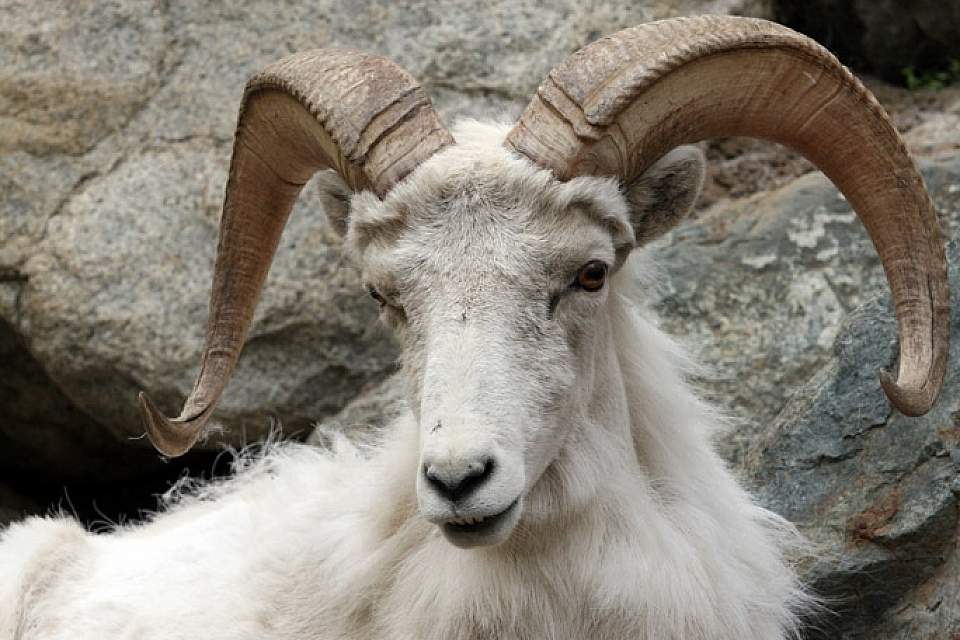
Windy Corner
30 mins from Downtown Anchorage along the Seward Highway
The premier spot to view wild Dall sheep in Alaska (and maybe the whole continent) looms over one of the state’s busiest highways south of Anchorage. Windy Corner often concentrates sheep on craggy faces just above the road. It’s not uncommon to see a half dozen sheep perched on cliffs in two or three spots, or grazing in patches less than 100 feet above. On rare occasions, the sheep actually venture right down to the highway. Alaskans regularly slow down and scan the terrain when driving past, and then zip into the pullouts when they see animals. A short and somewhat steep walk up the Turnagain Arm Trail will sometimes offer a different vantage of sheep not visible below.
Bird Point Wayside (Penguin Ridge)
40 Mins from Downtown Anchorage along the Seward Highway
The 3,000-foot slopes of Penguin Ridge overlook the Turnagain Arm south of Anchorage, providing habitat for both Dall sheep and mountain goats—one of the few places where the two species overlap. For best viewing opportunities, visit Bird Point Wayside of Chugach State Park. Extensive, multi-level observation decks feature panoramic vistas and spotting scopes. For best results, scan snow-free areas below ridgelines for white specs, then confirm with binoculars. Once you find grazing sheep or goats, use a spotting scope to zero in on single animals.
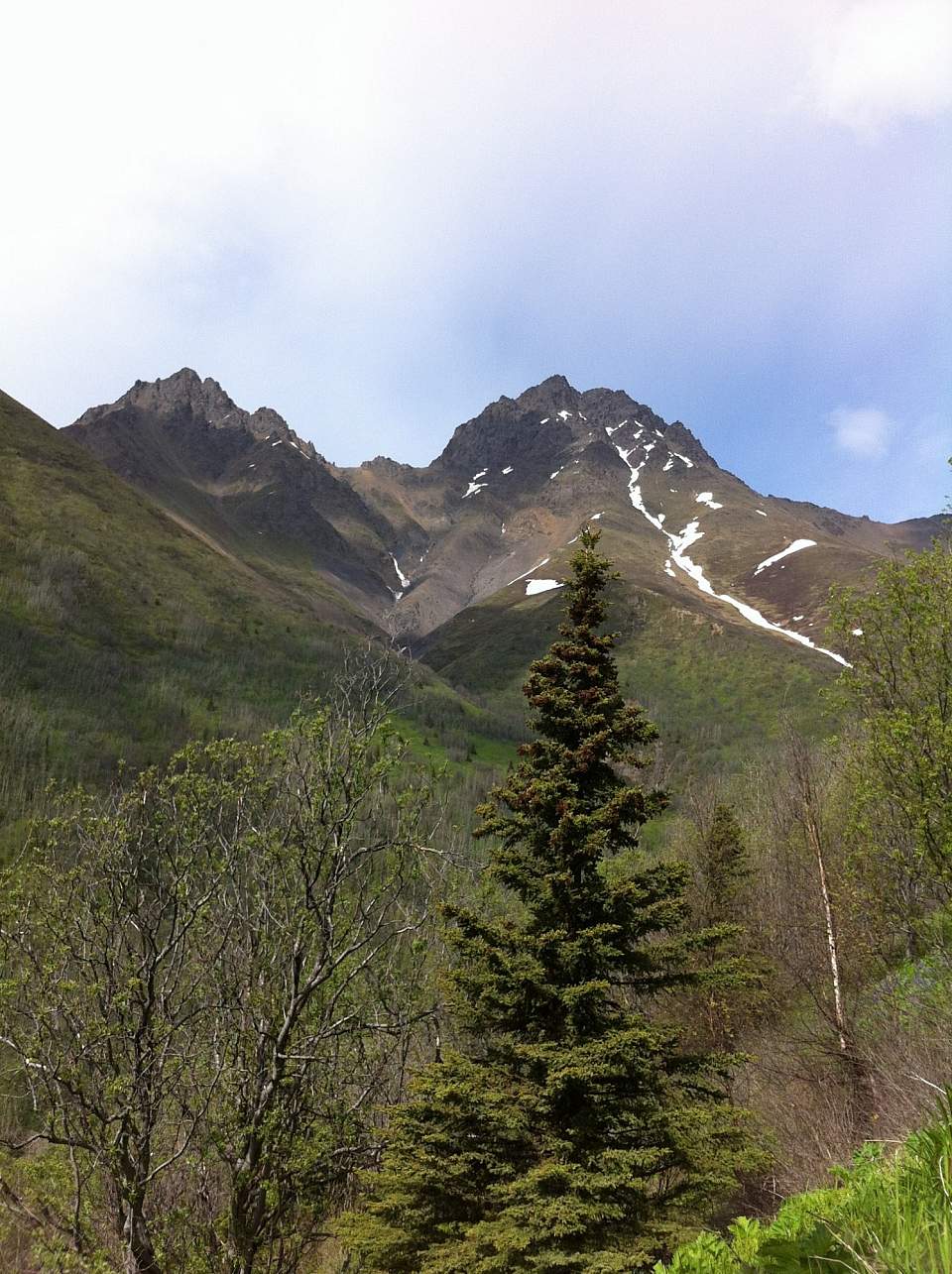
Scan the slopes beneath the towering Twin Peaks
Hiking in Chugach State Park
Powerline Pass Trail, 30 mins from Downtown Anchorage | Twin Peaks Trail, 50 mins from Downtown Anchorage
Dall sheep can sometimes be seen grazing on the slopes above the Middle and South Forks of Campbell Creek on the Anchorage Hillside in Chugach State Park. These animals will often appear as white specks in distant alpine meadows. From the Glen Alps trailhead, walk a half-mile to Powerline Pass Trail and use binoculars to scan below ridges across the valley, especially during spring and summer mornings.
Another productive area for sheep looms over the Eklutna Lake in the grassy south-facing bowls beneath Twin Peaks at the top of the strenuous 2.6-mile Twin Peaks Trail. It’s easiest to use binoculars or a spotting scope from the shoreline near the Eklutna Campground. But hikers can access the slopes for better views.
Tern Lake
1 hr 45 mins south of Anchorage on Seward Highway
A popular stop for wildlife viewing in general, this shallow, productive lake in the Kenai Mountains nestles between two immense faces that rise 3,000 to 4,000 feet above the valley floor. The slope to the northeast sometimes draws both mountain goats and Dall sheep into the open, one of the few places where both species overlap. The animals will be visible to the naked eye as white specks on the distant alpine tundra.
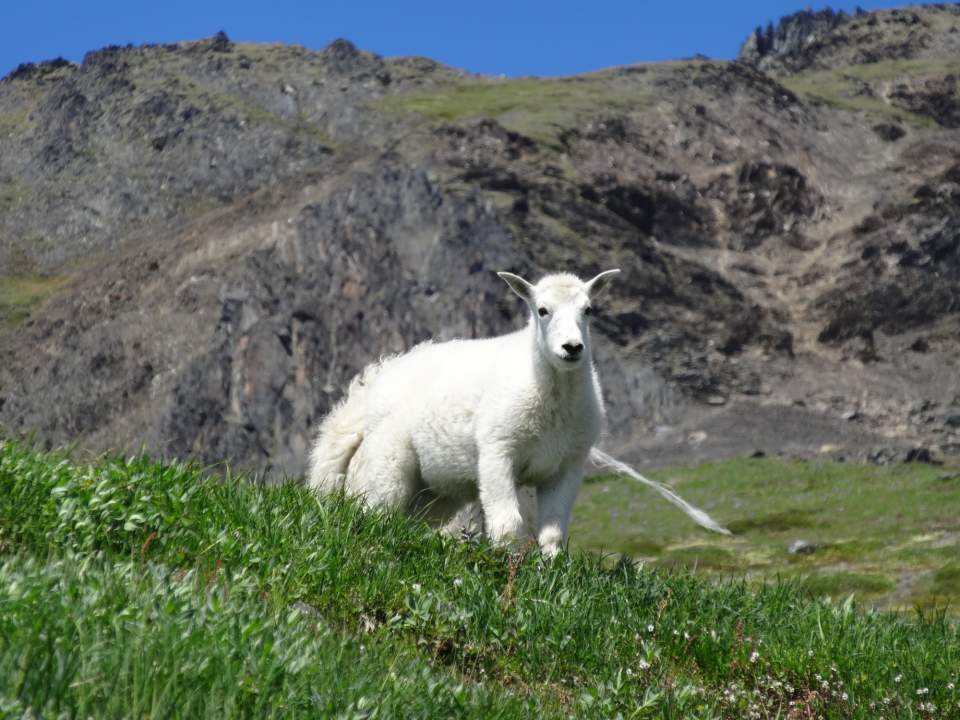
Baby goat seen from the Harding Icefield Trail
Day Cruise Resurrection Bay & Hike in Kenai Fjords National Park
2.5 hrs from Anchorage by car, 4 hrs by train
More than 4,000 mountain goats roam the backcountry of the Kenai Peninsula, most often in the craggy, glacier-rimmed slopes that overlook the Gulf of Alaska. The western coast of outer Resurrection Bay near Seward offers the state’s best opportunity to see wild goats up close, with animals often perched on ledges and crannies just above the sea. In fact, the goats are so common and easy to find that guides have nicknamed the stretch between Caines Head and Callisto Head as “goat alley.”
Goats are also not uncommon along the strenuous Harding Icefield Trail by Exit Glacier in Kenai Fjords National Park, but you will probably have to climb hundreds of feet to find them.
Denali National Park
5 hrs from Anchorage by car, 8 hrs by train. Bus Tour or Shuttle Inside the Park
Several thousand Dall sheep inhabit the high mountains in the eastern and western regions of the park, with several promising viewing sites accessible from the 92-mile Denali Park Road. In general, they feed and rest on windswept ridges and steep tundra slopes, while using rocks and crags to avoid predators. Venture out early on a bus tour or the national park shuttle and go as deep into the park as you have time for. Use binoculars and scan periodically for their white forms against the tundra. Also watch for the park’s other marquee mega-fauna: brown bears, grey wolves, caribou and moose.
Noted Spots Along the Park Road
- Savage River loop at Mile 15
- Primrose Ridge at Mile 16
- Upper Teklanika-Sanctuary River trails at Mile 22
- Igloo Creek Campground at Mile 34
- Toklat East Branch Trail at Mile 53.1
- Eielson Visitor Center at Mile 66
Sheep Mountain
2.5 hrs northeast of Anchorage along the Glenn Highway
This spectacular ridge dominates the Glenn Highway for almost 15 miles, climaxing one of the state’s most scenic mountain drives. The massif—about 120 road miles northeast of Anchorage—feels immense and wide open, with great vistas of its 3,000-foot slopes possible from just about any place along the highway. The terrain lives up to its name, too. These south-facing slopes can concentrate large numbers of sheep that are especially visible after green-up in the spring. Lodges in the area provide spotting scopes and good advice, and there are several pullouts and trailheads with safe parking. To preserve its extraordinary sheep viewing potential, the whole area has been closed to sheep hunting since before Alaska statehood.
Rainbow Ridge
5 hrs northeast of Anchorage, 2 hrs South of Fairbanks along the Richardson Highway
Dall sheep are easy to see on this very striking, postcard-worthy ridge that parallels the Richardson Highway for a few miles in the Alaska Range about 150 miles south of Fairbanks. With bands of rust-colored rock alternating with talus fingers and tundra, the terrain is almost perfect for showing off the white dots of grazing sheep. Winter winds also tend to clear the slopes, making the animals visible all year round, especially on the mid-level slopes above the brush zone. The ridge—including the 6,550-foot Rainbow Mountain—is also known for fossils and two rock glaciers slowly creeping downslope toward the highway.
Atigun Pass
7 hrs north of Fairbanks on the Dalton Highway
Some of the best sheep viewing in the world looms over the gravel James Dalton Highway as it traverses this 4,739-foot pass through the Brooks Range and then descends toward the Arctic coastal plain. Sheep can be found along sweeping open slopes between the pass and Galbraith Lake, with best chances of seeing activity between May and September. Ewes give often give birth near the lake, while the pass area is known as a rearing area for lambs. Overall prospects for other wildlife viewing are fantastic, with good chances for caribou, Arctic foxes, musk ox and migrating birds.
Guaranteed Sheep and Goat Viewing
Dall sheep and mountain goats can be elusive, especially when wet or stormy weather descends to obscure the view. Even a visit to Windy Corner on Turnagain Arm—where sheep regularly appear—will sometimes prove futile. If you don’t mind seeing animals under human care, you’re always in luck!
- Dall sheep and mountain goats are among the most exotic and popular denizens at the Alaska Zoo in Anchorage—usually orphaned or rescued animals living out their lives in a rocky, alpine-like habitat. 4731 O'Malley Road in South Anchorage.
Viewing Tips
- Sheep and goat viewing will be much more satisfying if you use a spotting scope or binoculars. Watch for white dots moving across slopes before and after snow season, and then zero in with good glass.
- These two hoofed species can be confused. Mountain goats have sharp black horns, with narrower chests and slightly off-white coats that grow much longer and raggedy in winter. They also sport a distinct goatish “beard.” Dall sheep are very white in appearance, with broader chests. They grow curved, amber-colored horns, with adult rams developing massive full curls.
- Sheep and goats don’t usually overlap. Most goats live on rugged mountain faces of Southeast and coastal Alaska, while Dall sheep inhabit drier alpine zones of mainland ranges like the Alaska, Chugach, Kenai and Wrangell-St. Elias. No sheep live in Southeast.
- EXCEPTION! Several locales in Southcentral Alaska actually attract both species, and they happen to include two road-accessible viewing areas.
- Penguin Ridge above Turnagain Arm (Bird Point Wayside)
- Cooper Landing area of Kenai Mountains (Tern Lake)
- Knik Glacier area
- McColl Ridge in Wrangell-St. Elias National Park
For More Information
- Dall sheep PDF from Alaska Wildlife Notebook
- A Dall sheep primer from game biologists
- Mountain goat PDF from Alaska Wildlife Notebook
- A mountain goat primer from game biologists
Show Map
Sheep & Mt. Goat Viewing Spots
Anchorage Area
The premier spot to view wild Dall sheep in Alaska (and maybe the whole continent) looms over one of the state’s busiest highways only 20 miles south of Anchorage.
The 3,000-foot slopes of Penguin Ridge provide habitat for both Dall sheep and mountain goats — one of the few places where the two species overlap.
This trail quickly gains elevation on its way to an alpine meadow framed by the dramatic Twin Peaks and Goat Rock, but climbs to magnificent views overlooking the entire valley. Dall Sheep are often spotted above the timberline. From here there is a spectacular view of the lake below. This is also a good place for berry picking in the fall. Because of the crushed rocks, the trail is hardly ever muddy.
Steep mountain walls, mountain peaks, beautiful valleys and streams, mature Sitka spruce forest, and areas rich in wildlife provide plenty of enjoyment. Dall sheep can sometimes be seen grazing. Use binoculars to scan grassy fingers below ridges across the valley, especially during spring and summer mornings.
The Alaska Zoo started in 1966 with one baby elephant named Annabelle that was won in a contest. Since then, it has expanded to include over 77 animals across 25 acres of the Anchorage hillside.
Denali National Park
Either drive your own car or take the free shuttle 15 miles out the park road to the Savage River check station. This is a popular hiking trail, and you won’t be alone, but at least you’re away from the entrance area and entering the true wilderness of Denali National Park. This is a tundra walk on a developed trail that follows the river. Good hike for kids, with possibility of seeing Dall sheep, marmots, and caribou. You can do a loop walk, ...more
This is an unmarked, unmaintained trail and can be difficult to follow, but is a good example of the real outdoors in Denali National Park.
This informal hiking area begins at the Primrose rest area and heads up a gentle ridge until you reach the bench, which provides panoramic views of the park. Wildflowers are abundant in this area and usually peak between July 20 and August 10.
This hike does not require crossing any glaciers or dangerous streams, which makes for a good overnight hike for those who carry an overnight camping permit.
A great place to catch a glimpse of Dall Sheep, Igloo Mountain is also where the first dinosaur tracks in the park were discovered. You can see them yourself, if you go on one of the many easy day hikes that start here.
Igloo Creek is one of three tent-only campgrounds in the park. Situated right next to the creek, it is a great place to relax and enjoy the wilderness and the area around the campground offers great hiking opportunities.
Only 33 miles from the summit of Denali, and at an elevation of 3300’, Eielson offers some of the most spectacular views of Denali (formerly Mt McKinley). There are many activities you can do here, including ranger-guided hikes up to nearby Thorofare Pass and self-guided expiration of the high-alpine tundra environment.
Kenai Peninsula & Kenai Fjords National Park
The western coast of outer Resurrection Bay near Seward offers the state’s best opportunity to see wild goats up close, with animals often perched on ledges just above the sea — making the area a popular destination during marine wildlife cruises out of Seward.
A popular stop for wildlife viewing, this shallow, productive lake in the Kenai Mountains nestles between two immense faces that rise 3,000 to 4,000 feet above the valley floor. The slope to the northeast sometimes draws both mountain goats and Dall sheep into the open, one of the few places where both species overlap.
Whittier (Prince William Sound)
Look for mountain goats on this barren, newly-deglaciated rock face. The goats feed low down in the early summer then move higher as the snow melts and new foliage is exposed. By end of summer, they’re so high they appear like white dots.
Glenn Highway
South-facing slopes can concentrate large numbers of sheep that are especially visible after green-up in the spring. Lodges in the area provide spotting scopes and good advice, and there are several pullouts and trailheads with safe parking.
Richardson Highway
Dall sheep are easy to see on this postcard-worthy ridge that parallels the Richardson Highway about 150 miles south of Fairbanks. With bands of rust-colored rock alternating with talus fingers and tundra, the terrain is almost perfect for showing off the white dots of grazing sheep.
Dalton Highway
Some of the best sheep viewing in the world looms over the gravel James Dalton Highway as it traverses this 4,739-foot pass through the Brooks Range and then descends toward the Arctic coastal plain. Sheep can be found along sweeping open slopes between the pass and Galbraith Lake, with best chances of seeing activity between May and September.

